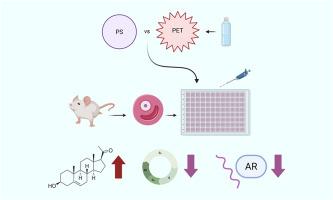聚苯乙烯和聚对苯二甲酸乙二醇酯纳米塑料对小鼠卵巢卵泡功能的影响不同
IF 7.3
2区 环境科学与生态学
Q1 ENVIRONMENTAL SCIENCES
引用次数: 0
摘要
接触微塑料和纳米塑料是不可避免的。食品和饮料中含有来自环境污染以及加工和包装材料的塑料颗粒,这些塑料颗粒通常由聚对苯二甲酸乙二醇酯(PET)制成。在人体组织如大脑、肝脏和胎盘以及卵巢卵泡液中已经检测到微塑料和纳米塑料,但对纳米塑料对女性生殖系统的影响知之甚少。此外,使用与环境有关的塑料类型和浓度进行的关于纳米塑料对健康影响的研究很少。因此,本研究验证了由球形聚苯乙烯(PS)制成的纳米塑料(一种常见的纳米塑料模型)与次级PET纳米塑料在环境相关剂量下对培养小鼠卵巢卵泡的影响不同的假设。卵巢是一个高度敏感的生殖器官,负责卵泡的发育,卵泡中含有卵母细胞,并产生类固醇激素。从成年小鼠卵巢中采集卵泡,用市售的球形220 nm PS纳米塑料(1-100 μg/mL)或实验室生成的240 nm PET纳米塑料(0.1-10 μg/mL)培养96小时。PS和PET纳米塑料暴露会抑制卵泡生长,并改变与类固醇合成、细胞周期和氧化应激相关的基因表达。PET纳米塑料增加孕烯醇酮水平,降低Cyp17a1的表达。总的来说,这两种塑料类型都改变了卵巢功能,但它们以相似的途径影响了不同的基因。这些发现表明,与环境相关浓度的纳米塑料暴露可能通过破坏激素和分子途径对女性生殖健康构成风险。此外,与环境相关的塑料类型和剂量对于研究纳米塑料对健康的影响是必要的。本文章由计算机程序翻译,如有差异,请以英文原文为准。

Polystyrene and polyethylene terephthalate nanoplastics differentially impact mouse ovarian follicle function
Exposure to micro- and nanoplastics is unavoidable. Foods and beverages contain plastic particles from environmental contamination and processing and packaging materials, which are frequently made of polyethylene terephthalate (PET). Micro- and nanoplastics have been detected in human tissues such as the brain, liver, and placenta, as well as in ovarian follicular fluid, but little is known about the effects nanoplastics have on the female reproductive system. In addition, few studies on the health impacts of nanoplastics have been performed using environmentally relevant plastic types and concentrations. Thus, this research tested the hypothesis that nanoplastics made of spherical polystyrene (PS), a common model nanoplastic, would have different effects on cultured mouse ovarian follicles compared to secondary PET nanoplastics at environmentally relevant doses. The ovary is a highly sensitive reproductive organ responsible for the development of follicles, which contain the oocyte, and production of steroid hormones. Follicles were harvested from adult mouse ovaries and cultured for 96 h with vehicle, spherical commercially available 220 nm PS nanoplastics (1–100 μg/mL), or lab-generated 240 nm PET nanoplastics (0.1–10 μg/mL). PS and PET nanoplastic exposure inhibited follicle growth and altered expression of genes related to steroid synthesis, cell cycle, and oxidative stress. PET nanoplastics increased levels of pregnenolone and decreased expression of Cyp17a1. Overall, both plastic types altered ovarian function, but they impacted different genes in similar pathways. These findings suggest that nanoplastic exposure at environmentally relevant concentrations may pose a risk to female reproductive health by disrupting hormonal and molecular pathways. In addition, environmentally relevant plastic types and doses are necessary for studying health impacts of nanoplastics.
求助全文
通过发布文献求助,成功后即可免费获取论文全文。
去求助
来源期刊

Environmental Pollution
环境科学-环境科学
CiteScore
16.00
自引率
6.70%
发文量
2082
审稿时长
2.9 months
期刊介绍:
Environmental Pollution is an international peer-reviewed journal that publishes high-quality research papers and review articles covering all aspects of environmental pollution and its impacts on ecosystems and human health.
Subject areas include, but are not limited to:
• Sources and occurrences of pollutants that are clearly defined and measured in environmental compartments, food and food-related items, and human bodies;
• Interlinks between contaminant exposure and biological, ecological, and human health effects, including those of climate change;
• Contaminants of emerging concerns (including but not limited to antibiotic resistant microorganisms or genes, microplastics/nanoplastics, electronic wastes, light, and noise) and/or their biological, ecological, or human health effects;
• Laboratory and field studies on the remediation/mitigation of environmental pollution via new techniques and with clear links to biological, ecological, or human health effects;
• Modeling of pollution processes, patterns, or trends that is of clear environmental and/or human health interest;
• New techniques that measure and examine environmental occurrences, transport, behavior, and effects of pollutants within the environment or the laboratory, provided that they can be clearly used to address problems within regional or global environmental compartments.
 求助内容:
求助内容: 应助结果提醒方式:
应助结果提醒方式:


